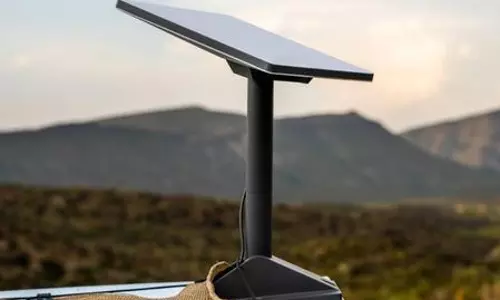
From Silk Roads to swipe wars: What a time to be living in?
text_fieldsImage for representation only
One random evening, you open Instagram and suddenly, your feed is all Chinese influencers. Reel after reel shows them walking through high-end warehouses, casually slashing the prices of luxury handbags, perfumes, and electronics. TikTok, suddenly unbanned in China for a few minutes, floods with clips promising Chanel for a fraction of the price. Links pop up for American buyers. A few taps in, you realize that this isn’t just some shopping hack.
Some videos go a step further: they offer itineraries. Fly into Guangzhou Baiyun Airport. We'll pick you up. We’ll take you straight to the livestream mall. You’ll shop, film, resell, and profit. Chinese tourism has turned into an economic strategy, not just for leisure, but for luxury arbitrage. It’s shopping-as-infrastructure.
You’re witnessing a trade war, not in shipping containers or diplomatic cables, but in pixels, swipes, and impulse buys. The battlefield is your feed. The weapon? Your attention.
We used to think trade wars happened at ports, with crates of electronics and steel. But today’s trade war doesn’t just hit GDP. It reshapes your algorithm. J.P. Morgan’s April report warns of volatility from tariff whiplash, but here’s the twist: that volatility itself has become a tradable asset. It's no longer about physical goods. It’s about data, speculation, and speed.
A 245+% tariff on Chinese goods? That’s just the opening act. The real drama is how platforms are reshuffling global influence: how Chinese livestream sellers are cornering global eyeballs, how American hedge funds bet on chaos, and how TikTok trends now signal market pulses better than a Bloomberg terminal.
Jodi Dean calls this the “digital ecology” - a network where the free flow of information feel democratic but are deeply manipulated. In this space, control isn’t top-down; it’s ambient. It’s coded into the platforms that host the influencers, into the APIs that curate what you see.
The U.S. and China don’t just compete over goods, they’re scrambling for infrastructure supremacy: who builds the semiconductors, who powers the AI, who owns the servers that carry livestream sales and stock market triggers. This isn’t just trade; it’s terrain.
But why do these platforms work so well? Enter Byung-Chul Han. He argues that capitalism has moved on from producing goods. It now produces aesthetics. In the hyper-digital age, you don’t need to own the Birkin; you just need to desire it. Engagement becomes the new transaction.
We see this in how markets react. A tariff announcement doesn’t just move gold. A tariff triggers a cycle of fear, memes, speculation, and click-driven panic. In this system, aesthetics aren't window dressing but the capital. Greenwashing? Stock-market TikToks and reels? Financial moods? These are designed to make volatility feel beautiful, even profitable.
And yet, no one sticks around for long. One week it’s gold. The next, it’s meme coins. Then it’s structured notes, bonds, Japanese equities, livestream sales. Bauman called these formations “swarms” which are collectives that gather, scatter, and reassemble based on nothing more than temporary desire. There's no loyalty, no ideology, just movement.
Investor behavior now mirrors consumer behavior: rapid, reactive, untethered. A TikTok about tariffs can move more people than a policy speech. A viral Chinese warehouse haul can dent perceptions of luxury faster than a recession. It’s not community. It’s swarm logic.
From an apartment in Bangalore, a metro ride in Delhi, or a pretty café from Calicut, you're watching something enormous unfold, not on TV, but on your phone, in real time, without a press briefing or ticker tape. India isn't a bystander anymore. The war between global tech titans, luxury conglomerates, and state power unfolds quietly on our screens and we’re wired right into the circuit. The front-facing camera isn't pointed at us, yet we’re implicated in every scroll. The feeds that tell us where to vacation or what skincare to trust are curated battlegrounds. You can now book a pickup from Shanghai airport, get driven directly to a state-curated shopping district, and livestream the experience to your followers in California or Chennai. This isn’t tourism. It’s a state-enabled interface for global desire.
Dean’s digital infrastructure doesn’t stop at borders; it coils itself into regional dialects, ad algorithms, and app interfaces. Han’s smooth surfaces — aesthetic, minimal, seductive — wrap around these infrastructures so they don’t feel like weapons. They feel like choices. Bauman’s swarms, then, are not only digital consumers — they’re also travelers, reviewers, resellers, affiliate marketers, each switching roles based on what’s trending this hour.
India, with its 800 million internet users, isn’t outside the frame. We're the perfect test market. A billion dopamine hits a day. High volume, high emotion, low commitment. Everything a digital war machine craves. You’re not watching this happen, you are happening there. Each tap, each 10-second skip, each cart abandoned or checkout completed, these are the new negotiations. And as your Reels page refreshes, you realize: the trade war isn't coming. It’s already here, wearing velvet gloves and holding out discount codes.
Put together, it becomes clear: the trade war isn’t just economic. It’s also aesthetic, infrastructural, and psychological. It’s no longer about who makes what, but who manages desire. Tariffs are headlines. Attention is currency. And power? Power belongs to whoever can control the scroll.
What a time to be living in!
(Nada Sulaiman is a PhD scholar in Christ University)


















